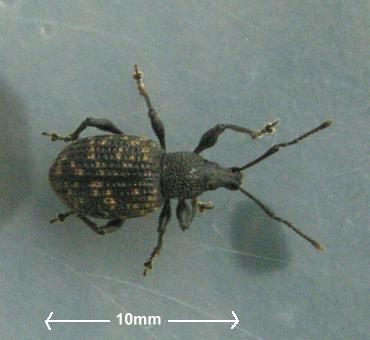 Adult |
Larva or grub |
Vine weevils have been increasing in significance to gardeners over the past few decades, due to the increased use of ornamental containers and container grown plants from nurseries. Recently a couple of species previously unrecorded in the UK have been spotted in the London area; they have probably arrived in plant pots and can overwinter in the milder environment of the city.
Do not mistake for a Ground Beetle
which is larger, flatter and not as pointed at the head
Euonymus leaves showing typical adult Vine Weevil attack
Their presence is shown by semi-circular notches eaten into the edges of leaves, most notably on evergreen shrubs like Rhododendron, Euonymus, Azalea and Camellia. This damage by the adults is not fatal, just unsightly (although is a good indicator that there will be eggs, and larvae hatching in the autumn). The real damage is done by the larvae or grubs, which feed on the roots often killing the plant, especially potted and young plants. The first sign of the presence of the larvae is usually yellowing leaves, poor growth and a wilting plant which does not respond to watering. Unfortunately it is often too late to save the plant. Rescue is possible if the damage is not too extensive, wash off all the compost to remove the grubs and remaining eggs, then replant in fresh growing medium. Some plants are more at risk from attack than others, eg. Sedums, Primulas, Fuchsias and Impatiens, but most plants in pots are at risk.
The adults are all female, reproducing by parthoengenesis (ie. they don't need a mate), and are flightless, but are very good walkers able to climb sheer surfaces. If one is spotted on a plant, arrange a tray or sheet directly below it as their favourite trick is to fall to the ground at the slightest disturbance and if this is not anticipated they are difficult to find.
Pre-pupal stage
They emerge from the pupa stage in late spring and after feeding on plant material for 21 to 45 days they are ready to lay between 500 to 1600 eggs over a one to two month period. These round eggs are about 0.8 to 1mm across, laid in the soil close to a plant; white at first they become brown later and very difficult to find Slow release fertilizer pellets for which they are often mistaken, are much larger and usually the yellow outer coating crushes easily, the eggs are relatively hard. They hatch 10 to 12 days later into the creamy-white larvae which burrow down to the fine roots - when found in the soil these are usually C-shaped and about 10mm long. A pre-pupal stage develops in December and remains like this until late spring when it pupates fully for a few weeks before the adult emerges.
Conditions for eggs and larvae are optimal when soil moisture is moderate to high in July and August. Heavy mulches help to maintain moisture levels, so removal of excessive mulch layers and minimal watering of plants during this period is detrimental to their survival. (Unfortunately surface rooted shrubs such as Camellias need to be well watered at this time to set the flower buds, so this must not be missed.) Excessively damp soils in the autumn also force larvae to move up the base of the plant where girdling can occur, so good drainage around the plants will ease the problem.
Indoors, the warmer conditions mean that they can reproduce all year round so all stages of the life cycle can be present at all times.
A natural predator is the Centipede which eats both eggs and larvae.
Treatments
*Imidacloprid is a neonicotinoid compound and these have been suggested as causative agents of colony collapse disorder (CCD) in Honeybees. The neonicotinoids have been shown to get into pollen and nectar; the European Food Standards Authority has produced a report warning of the danger to bees. |